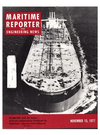
Study 56—'Sea Trade And Transportation Of Coal'
The so-called 1973 "oil crisis" had an important effect upon the international trade in hard coal, as it did much to arrest the decline in the use of coal as an energy source. However, up until now, the seaborne trade in hard coal has been centered almost entirely on the coking coal requirements of a handful of industrialized nations, with steaming coal accounting for only a negligible percentage of total movements.
Indeed, coking coal requirements will continue to be a more dominent influence on the pattern of trade, although steaming coal shipments will expand to a significant extent. The object of STUDY 56 "SEA TRADE AND TRANSPORT OF COAL" is not to confine discussion to the different characteristics of the coking and steaming coal trades, but rather to examine the total pattern of seaborne hard coal movements and to assess their influence on seaborne transport.
PART 1 of the Study is primarily designed as an introduction to the seaborne coal trade, and as such, discussion is focused upon the main characteristics of the coal market, with specific reference to seaborne trade movements.
This is followed, in PART 2, by a much more detailed analysis of the supply of hard coal.
The existing production, seaborne exports and future development plans of both the traditional and more recent suppliers are identified and discussed. This part of the Study provides the basis for an analysis of the pattern of seaborne hard coal movements which forms the subject of PART 3.
Included within PART 3 are detailed matrices on the international seaborne hard coal trade for the years 1973, 1974 and 1975. The major importing regions and their role in the existing pattern of trade are also examined.
The likely future import requirements of these regions are estimated in PART 4, which includes forecasts of demand for seaborne hard coal for 1980 and 1985. Within PART 4, particular emphasis is placed upon the import requirements of both Japan and the EEC.
PART 5 considers the sea transport of coal, examines the changes that have occurred in the organization of the trade, the structure of transport costs, vessel types and sizes employed in the coal trade and the constraints imposed upon these by ports, concluding with a discussion of the future trends in sea transportation.
For a copy of Study No. 56— "SEA TRADE AND TRANSPORTATION OF COAL," write to HPD Shipping Publications, 34 Brook Street, Mayfair, London W1Y 2LL, England. Orders for overseas @ U.S. $75. U.K. only @ £30 per copy.
Other stories from November 15, 1977 issue
Content
- ARINC Awarded $117,000 MarAd Study Contract page: 4
- Second $81-Million Gulf Oil Supertanker Christened At Bethlehem Sparrows Point page: 7
- Veliotis To Manage Electric Boat Div. page: 8
- Sun Shipbuilding Consolidates All Marketing Activities —Orth, Winstead And Hunt Named Department Heads page: 10
- Samson Ocean Systems Names John Williamson Regional Manager page: 10
- Hartzman To Retire- Bossier Slated For Avondale Presidency page: 11
- Ocean Orders Five More Ships page: 14
- M a r i n e Boiler Reliability page: 17
- Navy Awards Boeing $178 Million To Build Missile Firing Boats page: 19
- Plan To Convert Three Vessels At Estimated Cost Of $12.8 Million page: 20
- Kleschick Elected To Sun Ship Board Of Directors page: 20
- Norshipco Adopts New Corporate Logo page: 22
- Cayman Energy Ltd. Reports On Activities page: 22
- Samson Sells Marine Survey Division To Local Management page: 22
- Ed Toale Joins Bailey Sales Staff page: 23
- Marine Firms Attend Hoffert Marine Seminar page: 23
- $3-Million Surface Effect Ship Award To Philadelphia Gear page: 24
- Jonathan Feffer Named President SSI Navigation page: 24
- Navy Adds $4.2 Million To Tracor Contract page: 26
- C.F. Bean Corp. Names Charles R. Barron VP page: 26
- Argo International And Sealol Join Forces page: 27
- Space-Age Insulation Approved By Lloyd's page: 27
- Raytheon Promotes A. Newell Garden page: 28
- National Steel And Shipbuilding Delivers Second Of Four 90,000-Ton Tankers To OSG page: 28
- W.A. Whitney Corp. Introduces New 28XX Tooling Catalog page: 29
- Swan Hunter To Build Vessel To Transport Spent Nuclear Fuels page: 29
- Floating Oil Storage Better Prospects For The Unemployed? page: 34
- Alaska Maritime Names William Lorch Valdez Port Manager page: 36
- No. New England Section Of ASNE Reports On Two Technical Sessions page: 36
- Moran-Thibodeaux Names Captain North Vice President-Sales page: 38
- Diamond Manufacturing Building Ro/Ro Dock For Port Of Tampa page: 38
- Newport News Shipyard Installs Powerful Hoists page: 39
- Kawasaki Endows M.l.T. Research Fund With Gift Of $200,000 page: 39
- Todd Shipyards Corp. Holds Company Safety Conference In Chicago page: 40
- Study 56—'Sea Trade And Transportation Of Coal' page: 41
- Spanish Society And ABS Enter Agreement page: 42
- J.M. Ringelberg Joins Seaward International page: 42
- U Of California Gives Course On Deepsea Oil Structures Jan. '78 page: 43
- Slatic Named President Ameron Protective Coatings Division page: 43
- Two Management Appointments Announced At Skagit Corporation page: 44
- IMO Pump Bulletin Describes Twin Screw Pumps page: 44
- New England Company Receives U.S. Funds To Investigate Giant Sphere As Offshore Oil Terminal page: 46
- SNAME And SSC Plan Ship Vibration Symposium For Washington, D.C. October 1978 page: 47
- Electro-Nav To Market New 400-Watt SSB Transmitter/Receiver page: 48
- CIBRO Petroleum Building Super Barge At Todd Shipyards' Houston, Texas Division page: 48
- OMNITHRUSTER Names J. Michael Melvin VP page: 49
- Santa Fe Reenters Onshore Drilling !n The United States page: 49
- ASNE Flagship Section Holds First 1977-78 Meeting page: 50
- Wigham Poland Inc. Expands Marine Insurance Division page: 50

